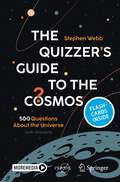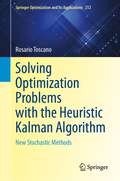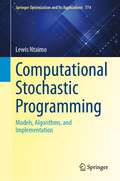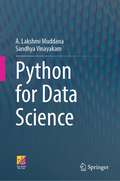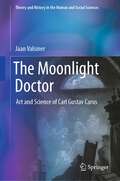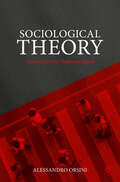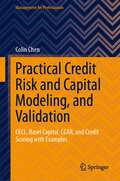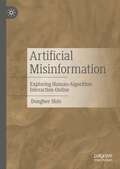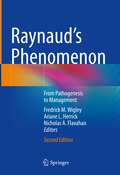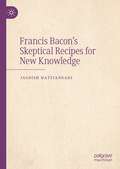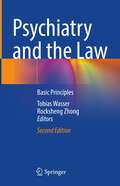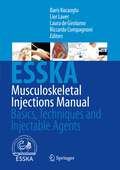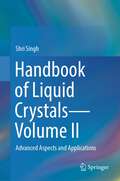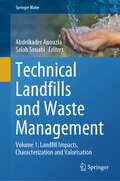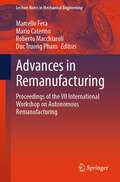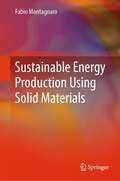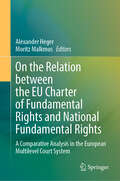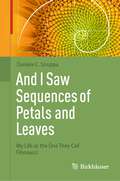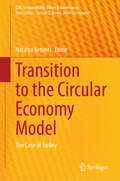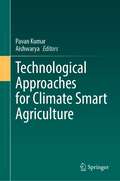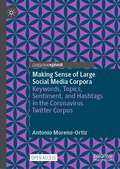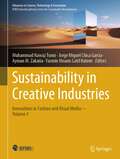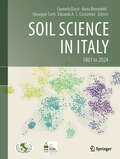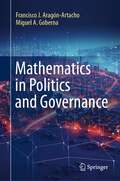- Table View
- List View
The Quizzer’s Guide to the Cosmos: 500 Questions About the Universe (with Answers) (Springer Praxis Books)
by Stephen WebbHave you ever gazed up at the night sky and wondered how many stars you can see? Whether the universe is infinite? Or, more prosaically, what the chances are of you being hit by a rock from space? The Quizzer’s Guide to the Cosmos is here to satisfy your curiosity by offering an overview of the history of astronomy, from the earliest beginnings through to the most recent discoveries. This isn’t a typical astronomy book, however — it’s packed with a 500-question multiple-choice quiz that not only makes the book more interactive but also helps you retain information and lets you test your knowledge of some of the most captivating concepts in science. The book will appeal to astronomy buffs and to general quiz afficianados alike. Digital questions and answers also via app: Download the Springer Nature Flashcards app free of charge and test your knowledge.
Solving Optimization Problems with the Heuristic Kalman Algorithm: New Stochastic Methods (Springer Optimization and Its Applications #212)
by Rosario ToscanoThis text focuses on simple and easy-to-use design strategies for solving complex engineering problems that arise in several fields of engineering design, namely non-convex optimization problems. The main optimization tool used in this book to tackle the problem of nonconvexity is the Heuristic Kalman Algorithm (HKA). The main characteristic of HKA is the use of a stochastic search mechanism to solve a given optimization problem. From a computational point of view, the use of a stochastic search procedure appears essential for dealing with non-convex problems.The topics discussed in this monograph include basic definitions and concepts from the classical optimization theory, the notion of the acceptable solution, machine learning, the concept of preventive maintenance, and more. The Heuristic Kalman Algorithm discussed in this book applies to many fields such as robust structured control, electrical engineering, mechanical engineering, machine learning, reliability, and preference models. This large coverage of practical optimization problems makes this text very useful to those working on and researching systems design. The intended audience includes industrial engineers, postgraduates, and final-year undergraduates in various fields of systems design.
Computational Stochastic Programming: Models, Algorithms, and Implementation (Springer Optimization and Its Applications #774)
by Lewis NtaimoThis book provides a foundation in stochastic, linear, and mixed-integer programming algorithms with a focus on practical computer algorithm implementation. The purpose of this book is to provide a foundational and thorough treatment of the subject with a focus on models and algorithms and their computer implementation. The book’s most important features include a focus on both risk-neutral and risk-averse models, a variety of real-life example applications of stochastic programming, decomposition algorithms, detailed illustrative numerical examples of the models and algorithms, and an emphasis on computational experimentation. With a focus on both theory and implementation of the models and algorithms for solving practical optimization problems, this monograph is suitable for readers with fundamental knowledge of linear programming, elementary analysis, probability and statistics, and some computer programming background. Several examples of stochastic programming applications areincluded, providing numerical examples to illustrate the models and algorithms for both stochastic linear and mixed-integer programming, and showing the reader how to implement the models and algorithms using computer software.
Python for Data Science
by A. Lakshmi Muddana Sandhya VinayakamThe book is designed to serve as a textbook for courses offered to undergraduate and graduate students enrolled in data science. This book aims to help the readers understand the basic and advanced concepts for developing simple programs and the fundamentals required for building machine learning models. The book covers basic concepts like data types, operators, and statements that enable the reader to solve simple problems. As functions are the core of any programming, a detailed illustration of defining & invoking functions and recursive functions is covered. Built-in data structures of Python, such as strings, lists, tuples, sets, and dictionary structures, are discussed in detail with examples and exercise problems. Files are an integrated part of programming when dealing with large data. File handling operations are illustrated with examples and a case study at the end of the chapter. Widely used Python packages for data science, such as Pandas, Data Visualization libraries, and regular expressions, are discussed with examples and case studies at the end of the chapters. The book also contains a chapter on SQLite3, a small relational database management system of Python, to understand how to create and manage databases. As AI applications are becoming popular for developing intelligent solutions to various problems, the book includes chapters on Machine Learning and Deep Learning. They cover the basic concepts, example applications, and case studies using popular frameworks such as SKLearn and Keras on public datasets
The Moonlight Doctor: Art and Science of Carl Gustav Carus (Theory and History in the Human and Social Sciences)
by Jaan ValsinerThis is the very first authoritative book on the role of Carl Gustav Carus (1789-1869) in the history of psychology. Carus was the initiator of the notions of development, unconscious, and archetype in psychology. The book emphasizes the interdisciplinary focus of Carus’ work as it was based on the literature and art of his time and is closely related with medicine and Naturphilosophie. The readership of the book will get access to the life course of a key figure of science of the 19th century.
Sociological Theory: From Comte to Postcolonialism
by Alessandro OrsiniThis textbook analyses the work of classical and contemporary sociological theorists. The first part is dedicated to Comte, Spencer, Marx, Durkheim, Weber, Pareto, and Simmel. The second part covers the major contemporary sociological perspectives: Functionalism, Marxism, Conflict Theory, Symbolic Interactionism, Phenomenological Sociology, and Rational Choice Theory. The third part is devoted to Postmodern Theory, Feminist Theory, Postcolonial Theory, and Race Theory. The author combines academic rigour with clear and accessible language, offering students an in-depth and extensive overview of the main, recurring problems that have troubled sociological theory from its origins to the present day. The textbook uses contemporary examples, analysing how sociological theory can explain the most tragic phenomena of our time, including the war in Ukraine, the Israeli-Palestinian conflict, US-China competition over Taiwan, nuclear proliferation, radicalization, neofascism, white suprematism, jihadism, and terrorism. With pedagogic features aiding learning, this book helps navigate the various approaches, methods, and research that divide sociologists into distinct schools. This textbook is therefore an invaluable tool to any sociology student looking to gain a comprehensive understanding of the foundational thinkers that have shaped the discipline.
Practical Credit Risk and Capital Modeling, and Validation: CECL, Basel Capital, CCAR, and Credit Scoring with Examples (Management for Professionals)
by Colin ChenThis book provides professionals and practitioners with a comprehensive guide on credit risk modeling, capital modeling, and validation for Current Expected Credit Loss (CECL), International Financial Reporting Standard 9 (IFRS9), Basel Capital and Comprehensive Capital Analysis and Review (CCAR) procedures. It describes how credit risk modeling, capital modeling, and validation are done in big banks with code and examples. The book features innovative concepts such as Binary Logit Approximation (BLA) for Competing Risk Framework; Adaptive and Exhaustive Variable Selection (AEVS) for automatic modeling; Full Observation Stratified Sampling (FOSS) for unbiased sampling; and Prohibited Correlation Index (PCI) for Fair Lending Texts. It also features a chapter on credit underwriting and scoring, addressing the credit underwriting risk with some innovations. It is a valuable guide for professionals, practitioners and graduate students in risk management.
Artificial Misinformation: Exploring Human-Algorithm Interaction Online
by Donghee ShinThis book serves as a guide to understanding the dynamics of AI in human contexts with a specific focus on the generation, sharing, and consumption of misinformation online. How do humans and AI interact? How is AI shaping our understanding of ourselves and our societies? What are the interaction mechanisms that govern how humans and algorithms contribute to misinformation online? And how do we bridge the gap between ethical considerations and practical realities to make responsible, reliable systems? Exploring these questions, the book empowers humans to make AI design choices that allow them meaningful control over AI and the online sphere. Calling for an interdisciplinary approach toward human-misinformation algorithmic interaction that focuses on building methods and tools that robustly deal with complex psychological/social phenomena, the book offers a compelling insight into the future of AI-based society.
Raynaud’s Phenomenon: From Pathogenesis to Management
by Fredrick M. Wigley Ariane L. Herrick Nicholas A. FlavahanThis book comprehensively reviews the understanding of a disorder that continues to challenge primary care clinicians and specialists. Raynaud’s phenomenon is an inappropriate and exaggerated response of the digital and cutaneous circulation to cold environmental temperatures. It is common, often causing significant morbidity and it is a major challenge for physicians at every level and specialty. A comprehensive review of Raynaud’s is now timely because of the incredible progress in understanding the molecular mechanisms of the normal regulation of cutaneous blood flow and how disease can disrupt the function of these specialized vessels. Likewise, the clinical implications of Raynaud’s phenomenon are better appreciated with studies defining its prevalence, the associated diseases, and new treatment approaches for patients suffering from it. The nomenclature used to classify cases has changed over the years and is important to understand these terms both for clinical care andresearch. This fully updated second edition comprehensively discusses various causes of Raynaud’s phenomenon including childhood Raynaud’s phenomenon, Raynaud’s phenomenon secondary to connective tissue disease, occupational causes, and a variety of other associated disorders. Careful consideration is given to the diagnosis of Raynaud’s phenomenon with state of the art discussion of nailfold capillary examination, non-invasive imaging, angiography, and appropriate serological testing. The concept that Raynaud’s phenomenon is associated with systemic disease or can be the manifestation of a systemic vasospastic disorder is also presented. In addition to reviewing both non-drug and drug therapy for patients with Raynaud’s phenomenon, this volume provides a practical approach in specific clinical situations by presenting problematic cases and the authors’ expert opinions on therapy. It also discusses mechanisms contributing to the vascular dysfunctionof primary Raynaud’s phenomenon and the vascular disease of secondary Raynaud’s phenomenon. Engaging readers with case vignettes and a plethora of visual aids, Raynaud’s Phenomenon: From Pathogenesis to Management is a state-of-the-art, authoritative reference and invaluable contribution to the literature that will be of interest to adult and pediatric physicians, rheumatologists, and clinical and basic researchers.
Francis Bacon’s Skeptical Recipes for New Knowledge
by Jagdish HattiangadiThe book sets an ambitious goal. It devises a new account of scientific methodology that makes it possible to explain how scientists manage, at least occasionally, to find true models of reality. The new methods may be contrasted with all those currently available that employ “coherence theories” of knowledge. Under this designation are grouped positions that can seem very different (such as those of Poincaré, Duhem, Popper, Hempel, Quine, Kuhn, and Feyerabend) but are united by the idea that the most general statements of science are merely hypotheses. They may be conjectures, opinions, conventions, posits, paradigms, or even myths. The most we can claim to know from such generalities is that they are internally consistent and coherent with empirical data. Consistency is insufficient to establish the truth of a conceptual system because many different systems, perhaps an infinite number, can be logically consistent and cohere with recorded data. Such is the well-known problemof the empirical under-determination of theories. Francis Bacon’s Skeptical Recipes for New Knowledge suggests a new methodology that solves this fundamental problem of knowledge.
Psychiatry and the Law: Basic Principles
by Tobias Wasser Rocksheng ZhongThis book is designed to help new psychiatrists and other medical professionals confront the complicated legal and ethical issues that arise at the intersection of the mental health and judicial systems. The law provides the boundaries in which clinical care operates. Appreciating these boundaries is particularly important when working with individuals whose rights may already be curtailed (forensic settings, for example). Understanding how psychiatry and the law interface provides students and trainees with a foundation for building their skills and attitudes through training and beyond. This text can guide or supplement education on the legal regulation of psychiatry, the use of psychiatry to answer legal questions, and the treatment of individuals with criminal justice involvement.In the second edition of this text, the editors have updated several chapters with new information and added chapters covering topics not addressed in the first edition. Each chapter begins witha clinical case vignette that brings the topic to life through a clinical encounter, the majority of which are based on landmark legal cases that set a historical precedent. The text presents details of the legal case, historical significance, and the precedent it set before discussing the core principles of the subject area. Each chapter reviews the existing literature and reinforces the most salient points. Topics include risk assessment, substance misuse and the law, legal issues within child and adolescent psychiatry, involuntary medication considerations, and other challenges that are often not sufficiently addressed in training.Psychiatry and the Law: Basic Principles covers a wide range of topics that would be suitable for use as the basis of a course in forensic psychiatry for psychiatry residents and is an excellent resource for new psychiatrists, psychologists, social workers, students, and other professionals navigating medical and legal boundaries in clinicalpractice.
Musculoskeletal Injections Manual: Basics, Techniques and Injectable Agents
by Baris Kocaoglu Lior Laver Laura De Girolamo Riccardo CompagnoniThis book presents a comprehensive and updated overview of musculoskeletal injections with biologic and non-biologic injectable agents – a new trend of treatment in orthopaedics and sports medicine.This ESSKA book incorporates internal ongoing debates fostered by ESSKA U45 Committee and ESSKA’s Orthobiologics Initiative (ORBIT), which enroll a broad international group of dedicated clinicians and researchers. The topics covered mirror this fast evolving field which ranges from basic science knowledge to treatment options in sports traumatology. Renowned experts in the field examine and critically discuss each aspect, including existing controversies concerning indications and applications as well as the choice between biologic and non-biologic injections. Clear practical indications, subdivided by anatomical region and supported by a wealth of intra-procedural images, are aimed to support young surgeons in the application of musculoskeletal injections. Written by an international panel of clinicians and researchers, active in the field of orthobiology and sports medicine, this manual is an invaluable reference tool for all those involved in injectional therapies and sports traumatology.
Handbook of Liquid Crystals—Volume II: Advanced Aspects and Applications
by Shri SinghThis expert and self-contained authored handbook provides comprehensive coverage of liquid crystals from the fundamental materials science, physics, and modeling through cutting-edge applications. Written by an author with over 40 years of active experience in this growing field, it offers an unprecedented self-contained treatment of this key research area.Liquid Crystals are a state of matter sharing properties that are usually associated with both solids and liquids. Their study belongs to wider field of soft condensed matter physics, an area growing in importance because of the new physics being discovered and the possibilities of various technological applications being developed. Liquid crystals continue to have a revolutionary technological impact and consistently pose new challenges of basic understanding. While the experimental side of liquid crystal research is very well developed, theoretical understanding has lagged, and this volume fills a gap in the published literature in terms of rigorous treatment of mathematical and computer modeling approaches.Volume II of this handbook deals with advanced aspects of liquid crystals and their applications, covering computer simulations of phase transitions in liquid crystals, liquid crystals of biomolecules, and defect textures in liquid crystals. Overall, this handbook serves as the ultimate scholarly guide for researchers, scientists, and engineers seeking to unlock the full potential of liquid crystals. It offers a comprehensive understanding of these materials and their diverse applications, empowering readers to navigate the complex intricacies of liquid crystal science and technology.
Technical Landfills and Waste Management: Volume 1: Landfill Impacts, Characterization and Valorisation (Springer Water)
by Abdelkader Anouzla Salah SouabiA "zero waste" society and the "circular economy" trend are urgently needed. Even if achieving 100% trash recycling and a fully circular economy may not always be attainable, aiming toward this goal might result in a sustainable future. Municipal solid wastes pose a hazard to the environment because of open burning, landfills, reckless disposal, and many other factors. Waste is being thrown away in more significant quantities and is made up of several different materials. Municipal solid waste (MSW) characteristics must be carefully considered when developing, implementing, or modifying solid waste management systems. Local waste variables that vary with cultural, climatic, socioeconomic, and institutional capacities are crucial for developing efficient waste management techniques. This book provides a comprehensive overview of landfills' situation, their categories, and the types of garbage they receive. The final section of the study provides an overview of prospective waste management techniques, their restrictions, and the potential areas for further research on landfill sites. This book has the advantage that world-class experts in their respective fields have written each chapter. As a result, this book presents a balanced picture across the whole spectrum of chapters on municipal solid wastes.
Advances in Remanufacturing: Proceedings of the VII International Workshop on Autonomous Remanufacturing (Lecture Notes in Mechanical Engineering)
by Marcello Fera Mario Caterino Roberto Macchiaroli Duc Truong PhamThis book features the papers presented at IWAR 2023. The overall objective of the event was to bring together international scientists and engineers to bridge the academic and industrial worlds in the field of remanufacturing. Various themes related to remanufacturing, including methods for operations management, methodologies for quality assessment and life cycle assessment, the integration of robots in remanufacturing, and the use of modern I4.0 technologies in a remanufacturing context among others were addressed. This book is intended for academics, graduate students, researchers, as well as industrial practitioners engaged in the field of remanufacturing.
Sustainable Energy Production Using Solid Materials
by Fabio MontagnaroThis textbook focuses on sustainable energy production using solid materials. With explanatory tables and figures, case studies, worked-out examples, and up-to-date bibliographies of other works, the book provides an in-depth exploration of the most innovative aspects of the field.Readers of the book will gain critical skills in characterizing and reacting to biomass, including the formation of pollutants, as well as using fluidized bed reactors for heterogeneous processes. The book also explores innovative methods for mitigating the greenhouse effect, reusing ashes as adsorbents or in cement production, and thermochemical solar energy storage. This book will give students, novice researchers, and industry professionals valuable insights and knowledge into the sustainable production of energy using solid materials.
Ethical and Legal Aspects of Computing: A Professional Perspective from Software Engineering (Undergraduate Topics in Computer Science)
by Gerard O'ReganThis textbook presents an overview of the critically important ethical and legal issues that arise in the computing field and provides a professional perspective from software engineering. The author gained exposure to these aspects of computing while working as a software engineer at Motorola in Ireland, where he coordinated the patent programme and worked with several software suppliers. Topics and features: Presents a broad overview of ethics and the lawIncludes key learning topics, summaries, and review questions in each chapter, together with a useful glossaryDiscusses the professional responsibility of computer professionalsExplores ethics in various civilisations and religious traditionsDiscusses ethical software engineering and ethical outsourcingConsiders what is fair and ethical in data scienceDescribes ethical challenges that arise in social media and the AI fieldReviews intellectual property including patents, copyright and trademarks This practical and easy-to-follow textbook/reference is ideal for computer science students seeking to understand legal and ethical aspects of computing. The text also serves as a concise self-study primer for software engineers and software managers.
On the Relation between the EU Charter of Fundamental Rights and National Fundamental Rights: A Comparative Analysis in the European Multilevel Court System
by Alexander Heger Moritz MalkmusThe sometimes complex and controversial relation between the fundamental rights of the European Union, as enshrined in the EU Charter of Fundamental Rights (CFR), and national fundamental rights in the context of constitutional review is reflected in a series of landmark decisions in the multilateral cooperation of European courts, which have reshaped the fundamental rights architecture in the multilevel system in recent decades. This book aims to contribute to a systematic and comprehensive analysis of the EU and constitutional law issues involved, thus serving as a reference point for scholars and practitioners dealing with this emerging topic in depth. Following this approach, it sheds light on the broader Union legal context of these developments, examines the role of the CFR for Constitutional Courts, the relationship between constitutional and ordinary courts, and assesses the key decisions concerning the application of the CFR as a standard of constitutional review. It also draws some initial conclusions on the development of the European fundamental rights architecture, its prospects and possible implications for the Union’s legal order. The book contains several contributions by European legal experts from academia and the judiciary, who examine the different methods of constitutional application of the CFR from a comparative law perspective. These contributions deal with the following aspects: first, the role of the CFR for the respective Constitutional Court with regard to the application of EU law as well as national law falling within the scope of the CFR; second, the relationship between the respective Constitutional Court and the ordinary courts with regard to the application of the CFR; third, the relevant facts and legal reasoning of the most important Constitutional Court decisions on the application of the CFR as a relevant standard of constitutional review; fourth, the relevant case law of the CJEU on the relationship between Union and national fundamental rights, as well as its broader implications for the multilateral cooperation of European courts. The individual chapters examine, inter alia, the following decisions: Verfassungsgerichtshof (Austria), March 14, 2012, U 466/11 et al.; Corte Constituzionale (Italy), January 23, 2019, Sentenza 20/2019; Bundesverfassungsgericht (Germany), November 6, 2019, 1 BvR 276/17; Tribunal Constitucional (Portugal), June 3, 2022, Acórdão 268/2022; Tribunal Constitucional (Spain), June 29, 2022, Sentencia Decision 89/2022.
And I Saw Sequences of Petals and Leaves: My Life as the One They Call Fibonacci
by Daniele C. StruppaIn this captivating historical novel, Daniele Struppa skillfully weaves a fictional autobiography, bringing Fibonacci to life with vivid details of his upbringing and adult years in Medieval Europe. As we explore the historical context of Fibonacci's time, we delve into the intriguing aspects of a bygone era, painting a compelling picture of a man whose contributions to mathematics continue to resonate today. From his groundbreaking work on congruent numbers to the famous numerical sequence that bears his name, the author invites readers to imagine the creative sparks that ignited Fibonacci's mathematical innovations. When historical evidence is elusive, accuracy and passion are seamlessly combined, offering plausible scenarios grounded in documented facts. A meticulously crafted apparatus of notes distinguishes fact from fiction, providing readers with a clear guide to navigate this enthralling reconstruction of Fibonacci's life. Step into the medieval world ofLeonardo Fibonacci, one of the most celebrated mathematicians in history, and discover the man behind the mathematical genius. Mathematicians and curious readers alike will appreciate the allure of Fibonacci's mathematical brilliance.
Transition to the Circular Economy Model: The Case of Turkey (CSR, Sustainability, Ethics & Governance)
by Natalya KetenciThis edited volume provides a multisectoral, multidisciplinary analysis of the circular economy in Turkey. The chapters delve into different segments of the economy, monitoring the progress of the transition to circularity as it is occurring. Written by experts in the circular economy, chapters touch on different aspects of the sustainability transition—from AI and entrepreneurship to luxury fashion to green finance. Chapters also refer directly to applicable UN Sustainable Development Goals, noting the progress made towards related development targets. This volume will be of use to students, academicians, experts, and professionals interested and working on different aspects of circular and green economies.
Technological Approaches for Climate Smart Agriculture
by Pavan Kumar AishwaryaThis volume presents up-to-date information on technological advancements in climate smart farming systems, covering crop modeling, irrigation practices, spatial modeling and agricultural policy in the context of climate change. The book presents the main applications in climate smart agriculture through technological approaches including the primary agricultural dynamics, mitigation strategies for sustainable soil and crop security, climate smart solutions to improve soil health, and crop and livestock productivity. It will be useful for scientists, environmentalists, meteorologists, environmental consultants, and computing experts working in the areas of climate-smart agriculture though technological approaches.
Making Sense of Large Social Media Corpora: Keywords, Topics, Sentiment, and Hashtags in the Coronavirus Twitter Corpus
by Antonio Moreno-OrtizThis open access book offers a comprehensive overview of available techniques and approaches to explore large social media corpora, using as an illustrative case study the Coronavirus Twitter corpus. First, the author describes in detail a number of methods, strategies, and tools that can be used to access, manage, and explore large Twitter/X corpora, including both user-friendly applications and more advanced methods that involve the use of data management skills and custom programming scripts. He goes on to show how these tools and methods are applied to explore one of the largest Twitter datasets on the COVID-19 pandemic publicly released, covering the two years when the pandemic had the strongest impact on society. Specifically, keyword extraction, topic modelling, sentiment analysis, and hashtag analysis methods are described, contrasted, and applied to extract information from the Coronavirus Twitter Corpus. The book will be of interest to students and researchers in fields that make use of big data to address societal and linguistic concerns, including corpus linguistics, sociology, psychology, and economics.
Sustainability in Creative Industries: Innovations in Fashion and Visual Media—Volume 3 (Advances in Science, Technology & Innovation)
by Muhammad Nawaz Tunio Jorge Miguel Chica Garcia Ayman M. Zakaria Yasmin Moanis Latif HatemIn this volume, sustainable creative industries become a beacon for innovative change, forging a path towards a conscious, harmonious world. This volume offers a panoramic view of the future, where innovations in fashion and visual media blend seamlessly with a commitment to a more sustainable and impactful world. More specifically, this volume explores the compelling interplay of sustainability, creativity, and advocacy, casting a spotlight on the transformative potential within fashion and visual media. It embarks on a journey through the innovative landscapes of fashion, where sustainability takes center stage, through an exploration of genderless mode development, contemporary patterns, and reimagined design strategies that breathe new life into tradition. As readers explore the chapters within, the symbiotic relationship between visual media and sustainability emerges, further delve into the evolution of visual communication design and the potency of Instagram microblogs in shaping perceptions and awareness. Furthermore, the role of design in disseminating critical information during disasters is unveiled and the ways in which narrative methods can ignite meaningful change explored.
Soil Science in Italy: 1861 to 2024
by Carmelo Dazzi Anna Benedetti Giuseppe Corti Edoardo A.C. CostantiniHistory is generally defined as “the study of past events, particularly in human affairs” and is mostly understood when presented chronologically. That’s why someone also defined it as the ‘chronological record of the past’. Knowing the past is extremely important for any society and human being. Past gives us insights into our evolving behavior in many matters of life. The book is seen as a unique opportunity to preserve the memory of the Italian history of soil science. It represents a milestone and a cultural heritage. Moreover, the book is a sort of ideal bridge between the pioneers of soil science in Italy and the young generation of researchers, contributing to spreading awareness of the importance of soil as a fundamental resource.
Mathematics in Politics and Governance
by Francisco J. Aragón-Artacho Miguel A. GobernaThis book presents the mathematical tools that politicians use to make rational decisions about health, education, culture, economy, finance, transportation, and national defense for their citizens. The selection of topics addressed is based on the experiences of four veteran politicians who have doctorates or master’s degrees in mathematics. The exposition also considers the mathematical tools used by politicians to capture votes or optimize their impact on the design of electoral districts, i.e., gerrymandering, without forgetting the mathematics applied to parliamentary activity and political science.Aimed at a general educated readership, a basic knowledge of mathematics is the only requisite to understanding most of the book. Certain sections, denoted in the book with a star, contain more advanced material and require some knowledge of undergraduate math. A later chapter is dedicated to applications and techniques of machine learning and the final chapter discusses a variety of cases where political decisions have affected mathematical development. Readers gravitating towards this book are those who are curious about the history of mathematics, including optimizers and mathematicians who would like to learn more about the historical roots of their discipline. There will also be strong appeal to mathematically-oriented economists, political scientists, and people generally interested in mathematics.Mathematics is – or it should be! – an important part of our culture. The impact of mathematics is sometimes silent, but a powerful one. The authors of this book did an incredible work in digging out areas of mathematical reasoning that pervades social and political life. Reading this book, we will all enrich our vision of mathematics’ value for society.(Nuno Crato, Professor of Applied Mathematics, University of Lisbon, former minister of Education and Science of Portugal 2011–2015)This monograph shows in an impressive way that mathematics can be very helpful in making and evaluating political decisions and that it is indispensable in the progressive penetration of all areas of society with scientific methods. This also includes politics. Not everything in politics can be justified or related to mathematics, but politics should not be made in contradiction to mathematical truths. For me, this is a central message of this publication.(Johanna Wanka, Professor of Applied Mathematics, Merseburg University of Applied Sciences, former Minister of Education and Research, Germany 2013–2018)
